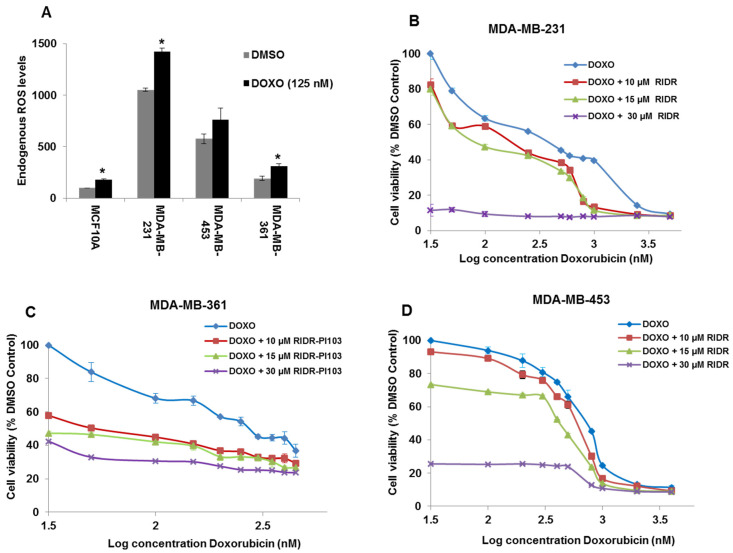Figure 2.
Doxorubicin induces ROS and combination of RIDR-PI-103 and Doxorubicin inhibit breast cancer cell viability. (A) Reactive oxygen species (ROS) levels were measured by DCFDA assay where MCF10A, MDA-MB-231, MDA-MB-361 and MDA-MB-453 cells were treated with or without 125 nM doxorubicin (DOXO) for 30 min. Dimethyl sulfoxide (DMSO) was used as vehicle control. Results are represented as mean ± SEM from 3 biological triplicates and represented graphically. * indicates p < 0.05 compared to DMSO treatment. (B) MDA-MB-231 cells (2 × 104 cells/well) were seeded in 96 well plates in triplicate and treated with a serial concentration of doxorubicin (DOXO) in presence of 10 µM, 15 µM and 30 µM RIDR-PI-103 (RIDR) for 72 h. The concentration of doxorubicin used was 500–5000 nM for MDA-MB-231. (C) MDA-MB-361 cells (2 × 104 cells/well) were seeded in 96 well plates in triplicate and treated with a serial concentration of doxorubicin (DOXO) in presence of 10 µM, 15 µM and 30 µM RIDR-PI-103 (RIDR) for 72 h. The concentration of doxorubicin used was 50–450 nM for MDA-MB-361. (D) MDA-MB-453 cells (2 × 104 cells/well) were seeded in 96 well plates in triplicate and treated with a serial concentration of doxorubicin (DOXO) in presence of 10 µM, 15 µM and 30 µM RIDR-PI-103 (RIDR) for 72 h. The concentration of doxorubicin used was 100–4000 nM for MDA-MB-453. All the cells were treated with MTT (5 mg/mL) for 4 h and absorbance read at 570 nm in a microtiter plate reader (n = 3 independent experiments performed in triplicate ± SEM).

